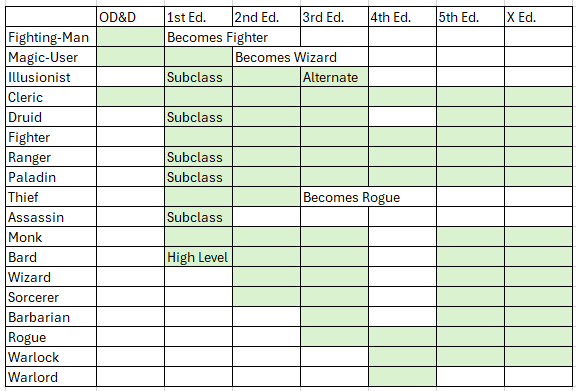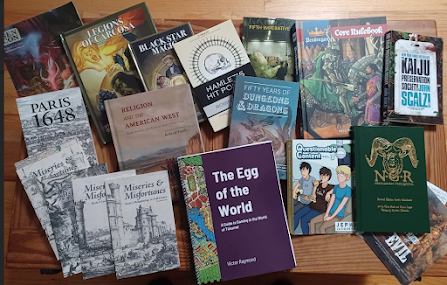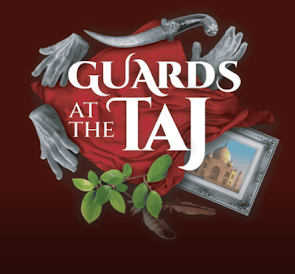So I got a copy of the new D&D Player's Handbook, and it's pretty good, but my problem is what to call the darned thing. The official WotC version is that it is just D&D. Not a new edition. Not a halfway 0.5 revision. Just D&D. OK, but how do I separate it from all the other D&Ds we've played over the decades? This got me quickly rabbit-holing down the various flavors of Dungeons & Dragons, and what it means to have a new edition. And if the latest version is really counts as a new edition or not.

And for the purposes of this discussion, I'm going to be talking about the main line development of the hardback books. There are a lot of interim points in this lineage that I'll touch on in passing (like Unearthed Arcana and the 3.5 edition), as well as the alternate D&D line of the three Basic Boxes, the BECMI line, and the D&D Cyclopedia. Not to mention the Open Gaming and OSR clones. Like I said, it is real easy to rabbit hole. I'm going to look at seven products and see where they differ. And what I'm looking at is primarily significant rule changes, particularly character creation and combat. To a lesser degree, I'll track presentation, because that evolves as well. Also influential on the discussion is who is writing these various editions, who is playing them and how the market has changed over the years, though that's really a story for another day.
Enough caveats? OK, let's get to it.
Let's start with the Original Gangster D&D - the little brown booklet in the woodgrain (later white) box. Dungeons and Dragons Rules for Fantastic Medieval Wargames Campaigns Playable with Paper and Pencil and Miniature Figures by Gary Gygax and Dave Arneson. in particular Volume 1, Men & Magic. Written and presented by people knowledgeable in wargaming, it required some understanding of miniature gaming. The original presented classes are Fighting-Man, Magic-User, and Cleric. The Races are Dwarves, Elves, and Hobbits (Changed to Halflings in later editions). The combat system was literally opaque to anyone who has not played Chainmail, but has as an Alternative Combat System the Attack Matrices for Men Attacking and Monster Attacking. These charts were the ones we were using back in the 70s when I started playing.
And while it doesn't tell you specifically how to create a character, it does state that "Prior to the character selection by players it is necessary for the referee to roll three six-sided dice in order to rate each as to various abilities, and thus aid them in selecting a role". Putting aside the note that the DM (not called as such yet) is rolling the players' ability scores, it does make generating ability scores the first step in character creation, followed by race, class, and everything else (including modifying those ability scores depending on class).
That's OD&D, our ground zero. The next step is Advanced Dungeons & Dragons Players Handbook (no apostrophe) by Gary Gygax, later called 1st Edition. And it stuns me when I see the quantum leap between those original booklets and what we find here. Big, sturdy hardback. Tiny type. A lot more definition on the rules, often with unique cases for specific situations. Character Classes are now Cleric, Fighter, Magic-User, Thief, and Monk, with the subclasses of Druid, Paladin, Ranger, Illusionist, and Assassin. Bards are there, but are in the back of the book as high-level play. Most of these classes showed up in other OD&D products or the Strategic Review, before becoming Core Canon. Races added the Half-Elf, Half-Orc, and Gnome. The attack matrices have moved to the Dungeon Masters Guide, but are the recognized method of combat (there was a year between PH and DMG - we used the tables from the original set during this lull). Saving throws are situational, as it was in the original flavor D&D, and it mattered you we being hit by a wand or dragon's breath.
In character generation, the player generates abilities first, then race, class, alignment, name, starting gold pieces, and hit points. Methods of ability score generation were also moved to the DMG, and four methods were provided; 1) roll four dice, drop the lowest, put the rolls in any order on your sheet. 2) roll 3 dice 12 times, keep the highest six, put them in any order 3) Roll in order listed, roll 3d6 six times each, keep the highest. 4) Roll 3d6 , in order, for 12 characters, then chose the character you want to run. Yeah, it sounds overly complex, but it fits with the complexity of the rest of the game. The ability scores in order were Strength, Intelligence, Wisdom, Dexterity, Constitution and Charisma. These were the Prime Requisites of Fighters, Magic-Users, Clerics, and Thieves, respectively, plus hit points and the dump stat (unless you were aiming at being a paladin).
The sheer massiveness of all this says that AD&D is clearly a different edition of the game, though still backwards compatible, in part because there was so much NOT Covered in the original. This was the version that showed up in the mall bookstores in the late seventies.
Then comes Second Edition, or rather the Advanced Dungeons & Dragons 2nd Edition Player's Handbook (note the apostrophe) by David "Zeb" Cook. Again, there's a presentation change as the accessible printing tech improves. Now we have a second color in the book, with full-color pages. The contents reflect the changes provided through a lot of the other 1st edition hardbacks, and excluded some (goodbye, Comeliness from the Unearthed Arcana, You are not missed.) from the canon.
 |
| Races/Species through the Editions |
The 2nd Edition has the least number of changes between the editions - THAC0, which was being used in conventions and embraced by the RPGA, is now fully incorporated (goodbye, attack matrices). The Half-Orc disappears from the racial lists. Classes are reorganized under four general groups - Warrior (with Fighter, Ranger, and Paladin all presented as equal classes), Wizard (Mage and Specialist Wizard, with Illusionist as a detailed example), Priest (Cleric, and Priest of a Specific Mythoi, with Druid as the specific example), and Rogue (Thief and Bard). The ones outside the "Big Four" character classes are presented as optional, but everyone used them in their base games anyway.
One of the major changes has been presentation and organization of the book - the order of chapters in the Player's Handbook, sketched out by editor Steve Winter- Ability Scores, Races, Classes, Alignment, Proficiencies, Money/Equipment, Magic, Experience, Combat, Treasure, Game and Combat Mechanics). This basic outline would remain pretty much intact until the most recent Player's Handbook.
Of the editions, the transfer between 1 and 2 is the slightest as far as core rules are concerned - a lot of this is necessary housekeeping. During the design there was discussion of more radical changes ("Hey kids! We're gonna nuke the Cleric!"), but in general this was a clearing of the kudzu and ivy that had grown up around the core rules. The arrival of 2nd Edition came along with the spread of the "Big-box bookstores", which needed a lot of content to fill its shelves.
The Third Edition, now (no longer Advanced) Dungeons & Dragons Player's Handbook Core Rulebook I by Jonathan Tweet, Monte Cook, and Skip Williams, was a major overhaul. THAC0 is banished. Higher armor classes are now better. Saving throws move from individual cases to three general classes (Fortitude, Reflex and Will). Feats and Skills are added. The races snap back to the 1st edition list with the return of the Half-Orc. The classes are Barbarian (back from Unearthed Arcana), Bard, Cleric (now with Domains), Druid, Fighter, Monk, Paladin, Ranger, Rogue (Formerly Thief), Sorcerer (new), and Wizard (With Illusionist as alternative, as opposed to a subclass).
Ability scores are re-arranged - Strength, Dexterity, Constitution (the physical scores), followed by Intelligence, Wisdom, and Constitution (the mental/social scores). More importantly, we see the rise of the ability modifiers as opposed to the ability scores themselves. The ability scores are rolled with four dice, drop the lowest, then assign. The order for character creation is Ability Scores, Class and Race, Assign/Adjust Ability Scores, Record Racial and Class Features, Select Skills, Select a Feat, Equipment, Record final you Skill and Combat Numbers, Finally Name, Gender, and Appearance.
 |
| Character Classes through the Editions |
Reversing the AC also has the effect of solidifying the D20 roll. THAC0 is abandoned for a more straightforward and modifiable die roll, though the result in play was often that the players and DM were hunting for plusses to see if they could boost the die roll into a success.
Presentation is upgraded as well - full-color throughout, and the art is more diegetic - looking like sketches that could be from within the fantasy world itself, he covers looked like ancient tomes, the pages looking like old parchment. It had a Conversion Manual to bring your game from 2nd to 3rd. They did eventually do a 3.5 revision, but kept the same layout, adding new abilities, class features, and skills, but it is not thought of as a new edition - it kept the 3 designation. Tap this one with the rise of the Internet booksellers.
Fourth Edition is the red-headed stepchild of the lineage, which is a pity, because it was a pretty good design, and if it was not D&D, it would have hailed as an important rival to D&D. On the cover it is Dungeons & Dragons Player's Handbook: Arcane Divine and Martial Heroes, Roleplaying Game Core Rules by Rob Heinsoo, Andy Collins, and James Wyatt. Ability Scores remained the same, though Constitution and Dexterity switched places. There are now three methods of rolling Ability Scores - 1) A standard array of six numbers, assigned by the player, 2) six basic scores, and spending 22 points to raise them, and 3) Roll four dice, drop the lowest, and assign them to your abilities.
The order of character creation is Race, Class, Ability Scores, Skills, Feats, Powers, Equipment, Number Skills (AC, hit points, attack and damage bonuses), Character Details (everything else). Race is missing the Half-Orc and the Gnome, but added now are the Dragonborn, Eladrin and Tieflings. Classes simplify to Cleric, Fighter, Paladin, Ranger, Rogue, Warlock (new), Warlord (new), and Wizard. Bard, Barbarian, Monk, Druid, and Sorcerer are all absent. Subclasses (called Paragon classes) branch off at 11th level. They also delve into general character roles (Controller, Defender, Leader, and Striker), but don't do much with that concept elsewhere.
But the big change here (the one that may have irritated a lot of people) was Powers - called different things (Prayers, Exploits, Spells), they a pretty much spells for every class and every level. And while this created a more balanced game, it also turned each class into a similar style of play (tracking your cards), and people did not care for that. This system, though, did survive in many of the D&D board games that showed up during this period.
Now, Fifth Edition, or simply the D&D Player's Handbook by Mike Mearls and Jeremy Crawford, (2014). In some ways it is a throwback to Third Edition. Ability Score order is the same as Fourth. You choose Race, Class, Ability Scores, a grab bag of descriptions ( alignment, ideals, bonds, flaws, and background), then equipment. The core classes change again to 12 total - Barbarian (back), Bard (back), Cleric, Druid (back), Fighter, Monk (back), Paladin, Ranger, Rogue, Sorcerer (back), Warlock, and Wizard. Races are everything from Fourth, minus the Eldrin, plus the return of the Half-Orc, and Gnome.
A big system change for this one was the use of advantage and disadvantage. Allowing rerolls was previously used for feats (lucky) or racial traits (halflings). Now they become situational, where you can roll two die and take the highest (or lowest in case of disadvantage). More importantly, any number of advantages can be negated by a single disadvantage, and vice versa. This helps avoid the hunting for bonuses seen in Fourth Edition.
And then, (FINALLY) we get to the new kinda-edition, also called the Dungeons & Dragons Player's Handbook. Bigger and beefier in page count. Completely revised text. Art is not nearly so bad as the Internet will tell you (though I did get the Gold Dragon cover, since I liked it better).
Part of the big change between PHs is organization. Mention of proficiencies, saving throws, skills, combat, and difficulty classes are moved to the front of the book, BEFORE you get to character classes, More importantly, there is a detailed rules glossary in the back, which allows them to mention something important in the front matter, then get into the gritty details later on. Combat comes early as well and that works out just fine, since I usually tend to start flipping pages when I have to deal with pages of each new character class abilities. This is the first edition I've seen where things like mounted combat is not relegated to a detailed discussion in the back (or the DMG), where most people never see it.
Creating a character is very different: Class, Origin, Ability Scores, Alignment, Details. Same twelve classes as 5.0. Origins are a new thing, a combination of species (formerly race, which grant special abilities), backgrounds (which affect ability scores, skills, and feats), and languages. We change up the species again, as the core species are Aasimar, Dragonborn, Dwarf, Elf, Gnome, Goliath, Halfling, Human, Orc, and Tiefling. Half-elf and Half-orc are gone again. As with the other editions, there is stuff that has been tried out in other products and then added to the core (like, say, Ranger abilities, which I have opinions on, but that is another discussion). Subclasses are back, but framed as a career choice when you hit 3rd level, similar to d20 Modern.
So, after all this, is this a new edition? If you compare it to the 1st to 2nd shift, the answer is definitely yes. In addition to changes in the system, it has been completely rewritten with an eye to clarity and presentation. If you look at the difference between 3 and 3.5, there are definite differences that could merit that designation as well (5.5). But if you compare it to its predecessor Fifth Edition, though, the core mechanics are all still there. It all depends where you draw the line as Core Canon. Does breaking up Race into Species and Background change everything? Do adding more Species/Races options count as a new edition? Is the way we handle subclasses enough of a change? The d20 resolution system first presented in 3rd edition is still there, and the Ability Score Modifiers are a piece that have survived since them.
Ultimately, I am good with calling the game Dungeons & Dragons in general usage, and when I'm talking about this particular version, I've decided to use the designation D24. As in the year of release. Here's my reasoning - the game will continue to evolve, particularly with the expansion of D&D Beyond and its table-top initiative, Sigil. Much like the old Strategic Review, or new options provided in hardbacks like Tasha's, there will continue to be expansion and development. But for Core Canon, which this is until the next edition shows up, I'm going with D24.
And that's my TED talk. More later,






